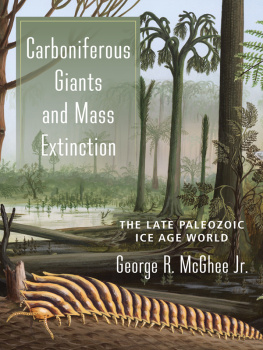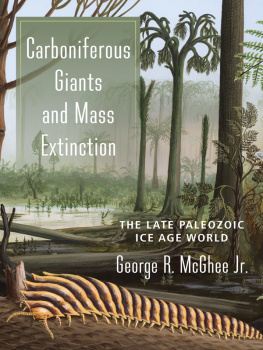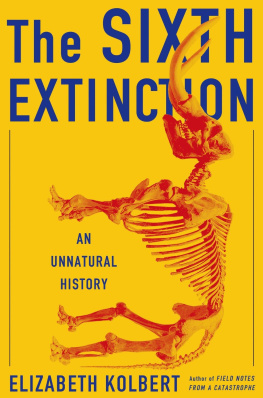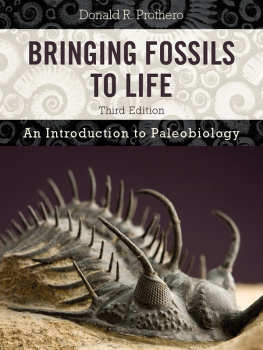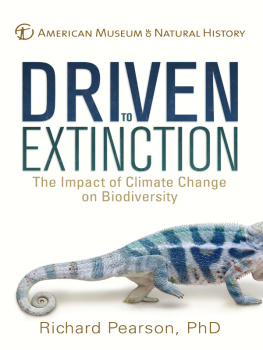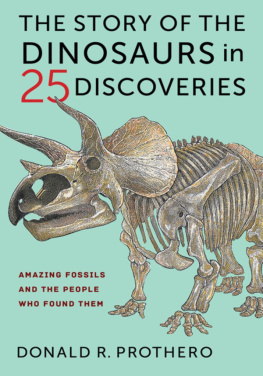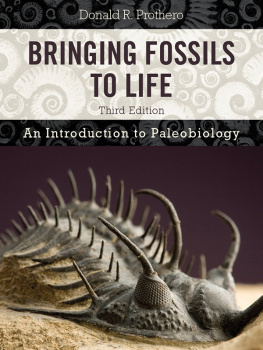Table of Contents
Columbia University Press
Publishers Since 1893
New York Chichester, West Sussex
cup.columbia.edu
Copyright 2018 Columbia University Press
All rights reserved
E-ISBN 978-0-231-54338-5
Library of Congress Cataloging-in-Publication Data
Names: McGhee, George R., author.
Title: Carboniferous giants and mass extinction : the late Paleozoic Ice Age world / George R. McGhee Jr.
Description: New York : Columbia University Press, [2018] | Includes bibliographical references and index.
Identifiers: LCCN 2017056021 (print) | LCCN 2017060808 (e-book) | ISBN 9780231543385 | ISBN 9780231180962 (cloth : alk. paper) | ISBN 9780231180979 (pbk.: alk. paper) | ISBN 9780231543385 (e-book)
Subjects: LCSH: Mass extinctions. | Extinction (Biology) | Climatic changes. | Glacial epoch. | PaleobotanyCarboniferous. | PaleontologyCarboniferous. | PaleoclimatologyPaleozoic.
Classification: LCC QE721.2.E97 (e-book) | LCC QE721.2.E97 M388 2018 (print) | DDC 560/.175dc23
LC record available at https://lccn.loc.gov/2017056021
A Columbia University Press E-book.
CUP would be pleased to hear about your reading experience with this e-book at .
Cover design: Lisa Hamm
Cover image: Richard Bizley / Science Source
Carboniferous insects. Artwork of a millipede (Arthropleura) and a dragonfly (Meganeura) in the forests of the Carboniferous Period (354290 million years ago).
Illustrations: (pages i, ii, and xiii) Mary P. Williams
For Marae
Tha grdh agam ortsa.
Contents
I magine living in a world in which a dragonfly-like insect with a wingspan similar to that of a seagull zooms past your head; multilegged millipedes as long as a small car and as wide as a truck tire are crawling along on the ground; venomous scorpions, stingers held curved over their backs, are as long as mid-sized dogs; and salamander-like animals are neither cute nor tinythey are as long as alligators and have mouths full of sharp-pointed, deadly teeth.
Imagine living in a world with huge expanses of land covered by tropical rainforests, a green band that stretches around the middle of the planet across all of the continents. Rainforests in which you discover, when you go hiking through them, very strange-looking trees: from a distance they look as though they have no leaves, even though the upper part of the trunk and the drooping branches of the tree are green. On closer examination, through a pair of field glasses, you can see that the tops of these trees do have leaves, but they are peculiar small bladelike leaves that partially overlap each other and wrap spirally around the branches and upper trunks. The tops of the trees thus have a somewhat fuzzy look, as though they were wearing green sweatshirts of leaves with multiple sleeves-of-leaves extending out along all of their branches. These peculiar sleeves-of-leaves look somewhat like those we see in our club mosses, but our little club mosses stand only 12 to 13 centimeters (five inches) high and these strange trees are gigantic, towering 50 meters (164 feet) into the sky.
Imagine living in a world in which a giant continent sits over the South Pole, a continent over five times larger than Antarcticaover twice the size of Africa, our largest single free-standing landmass surrounded by waterthat is covered with vast rivers of ice sheets stretching away from a huge, white, glacial polar cap.
That world is not imaginary; it is the Earthnot our modern Earth, obviously, but rather the Earth as it existed in the Carboniferous Period of the Paleozoic world, over 300 million years ago. All of the things described here actually existed on that Earththe giant animals, the giant trees, the giant continent, the giant glacial ice cap. There were giants in the Earth in those days.
This book is about that ancient Earth: how it came to be, and how it ended. We will examine the various hypotheses as to how animals, insects in particular, could have become so gigantic. We will examine the evolution of the great tropical rainforests that at first glance appear similar to those of our modern Earth, but that turn out to have been very different. The legacy of those great rainforests can be found around the world today in the massive deposits of coal that are found in Carboniferous stratathe huge volume of organic carbon that give the geologic period Carboniferous its name. Those coal deposits have been one of our major sources of energy since the beginning of the industrial era, and the burning of those coal deposits is releasing 300-million-year-old carbon dioxide back into our atmosphere and heating up the planet. The ancient Carboniferous Earth is transforming the modern Earth.
The Paleozoic world was totally destroyed in the end-Permian mass extinction, the greatest biodiversity crisis to occur since the evolution of animal life on Earth. The great ice caps of the Late Paleozoic Ice Age melted, the Earth began to warm, and the most catastrophic volcanic eruptions in Earth history began to inject trillions of tons of greenhouse gases into the Earths atmosphere. The resultant Hot Earth lasted for five million years, an apocalyptic world in which the tropics were lethally hota world in which vertebrate land animals could only survive in cooler latitudes higher than 30 in the Northern Hemisphere and higher than 40 in the Southern Hemisphere. In stark contrast to our modern worldwhere the equatorial tropics harbor the highest diversity of life on the planetthe equatorial region of that Hot Earth was almost totally barren. Even in the oceans, the equatorial temperatures were so high that fish and other vertebrate animals could only exist in the cooler waters of the high latitudes of the Earth. How could this have happened to the Earth? In this book we will examine in detail the triggers of the end-Permian mass extinction, and the nightmarish world that resulted.
This book is a summary of over four decades of my research into the ecological consequences of the Late Paleozoic extinctions, and I thank Columbia University Press, publishers of my previous books The Late Devonian Mass Extinction (1996) and When the Invasion of Land Failed: The Legacy of the Devonian Extinctions (2013), for making this third volume possible. I thank three anonymous reviewers of the manuscript for comments and suggestions that have helped me to improve the final book. And last, I thank my wife, Marae, for her patient love.
The late Paleozoic ice age lasted for ~67 m.y. [million years] in eastern Australia, and as such, it was the longest-lived icehouse interval in the Phanerozoic.
Fielding, Frank, Birgenheier, et al. (2008, 55)
ICE AGES IN EARTH HISTORY
We know that at least seven ice ages have occurred in the past 4,560 million years, time periods during which the Earth partiallyor almost entirelyfroze over. The history of the Earth is divided into four eons: the Hadean, Archaean, Proterozoic, and Phanerozoic, from oldest to youngest (for the geologic timescale, see ), much as our calendar years are divided into months, weeks, and days. We know from fossil evidence that ancient bacterial life was present on the Earth 3,450 million years ago, during the Paleoarchaean Era, and we have geochemical evidence that indicates that life was present even earlier during the Eoarchaean Era, some 3,830 million years ago (McGhee 2013; Nutman et al. 2016). The first four of the known ice ages occurred during the Proterozoic Eon, much later in time than the appearance of life on Earth, and three more ice ages occurred even later during the Phanerozoic Eon; thus life on Earth has successfully survived them allbut at a cost. Many of the ice ages are associated with periods of extinction and large losses of biological diversity, a topic that will be explored in more detail in the next section of this chapter.

